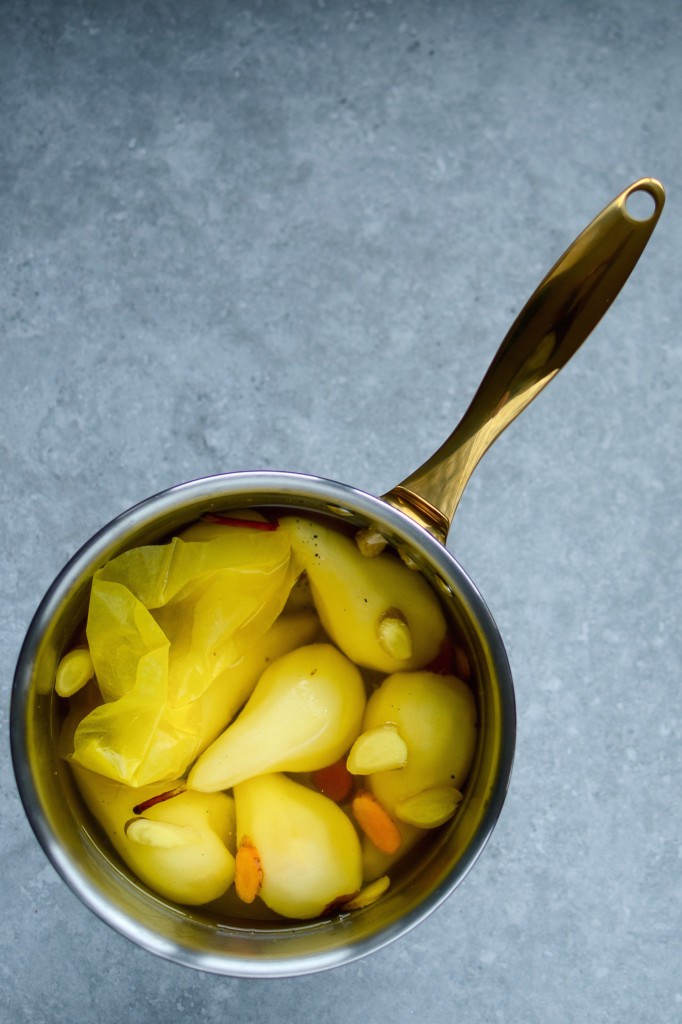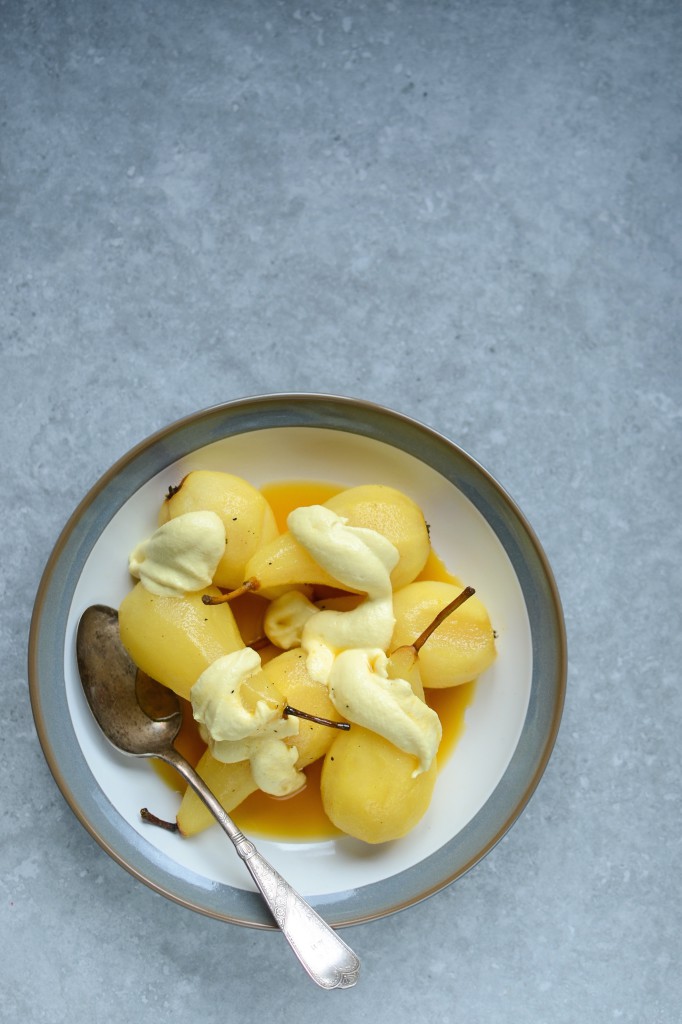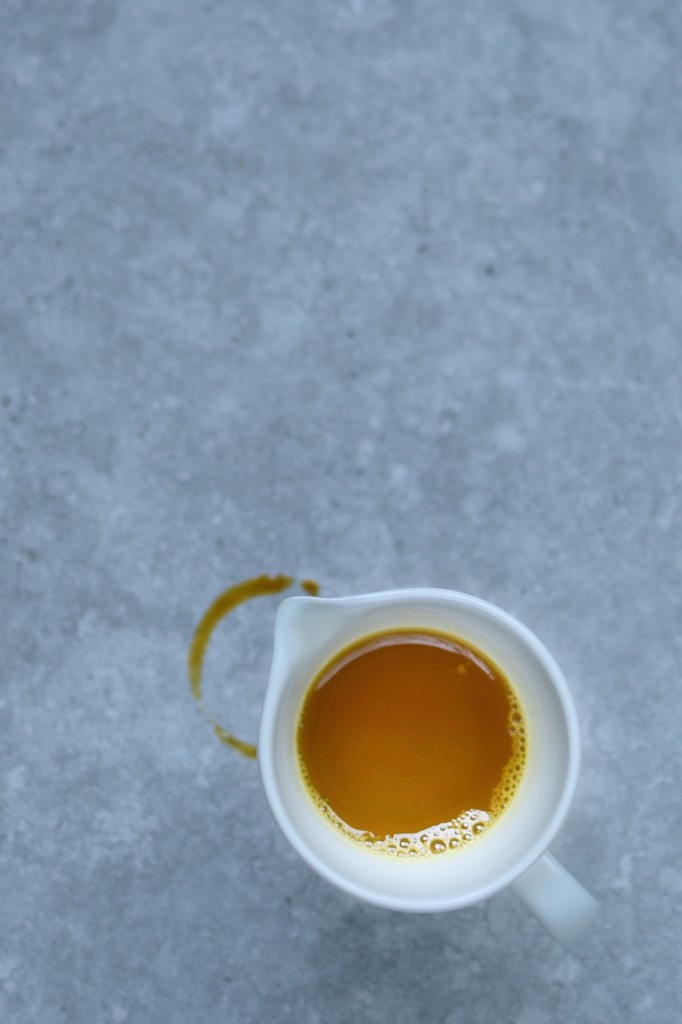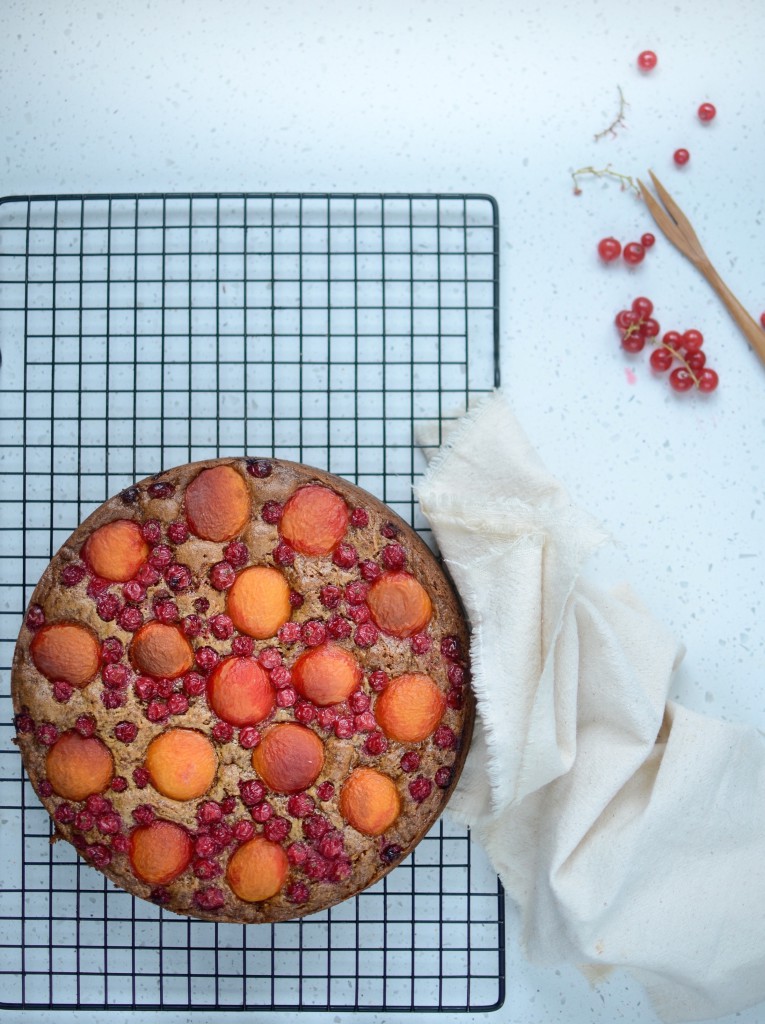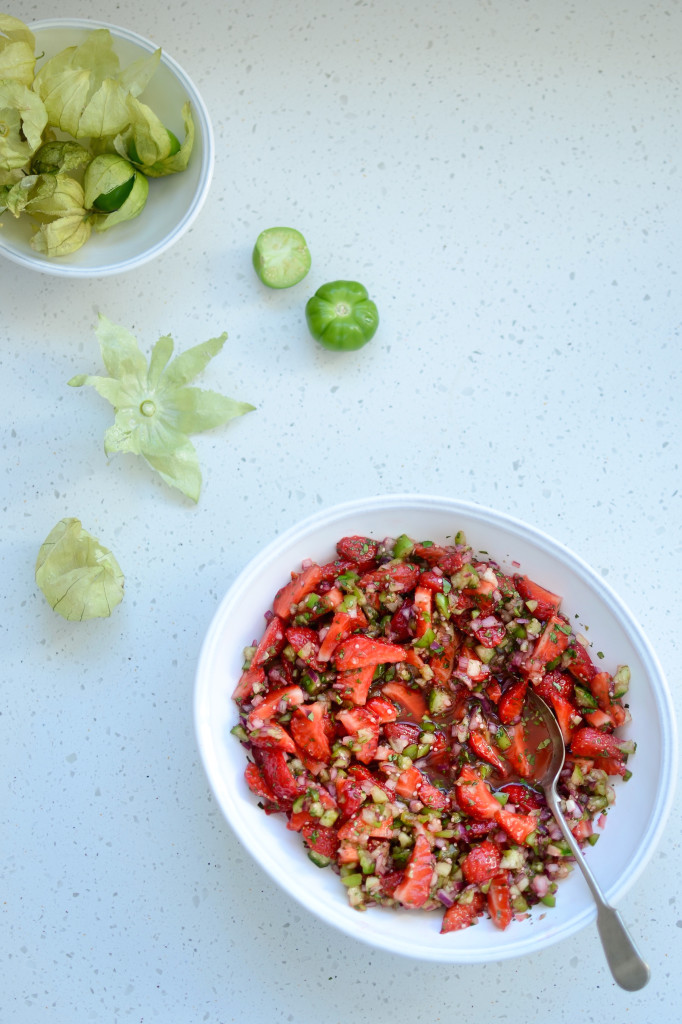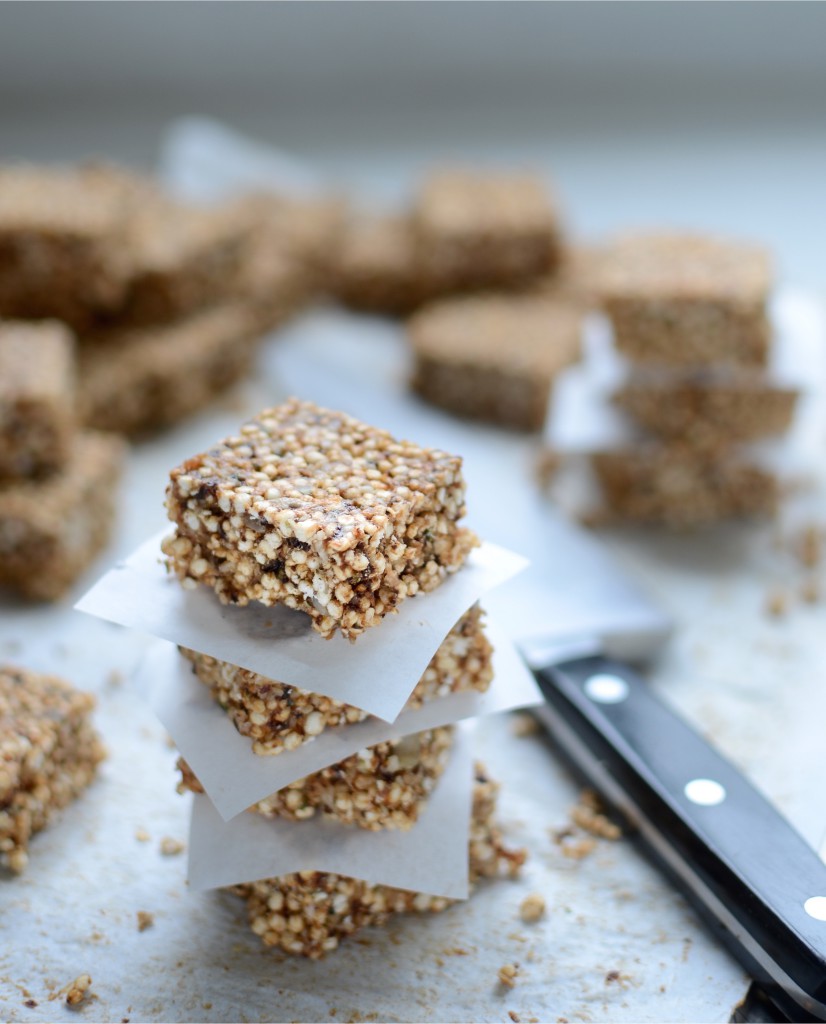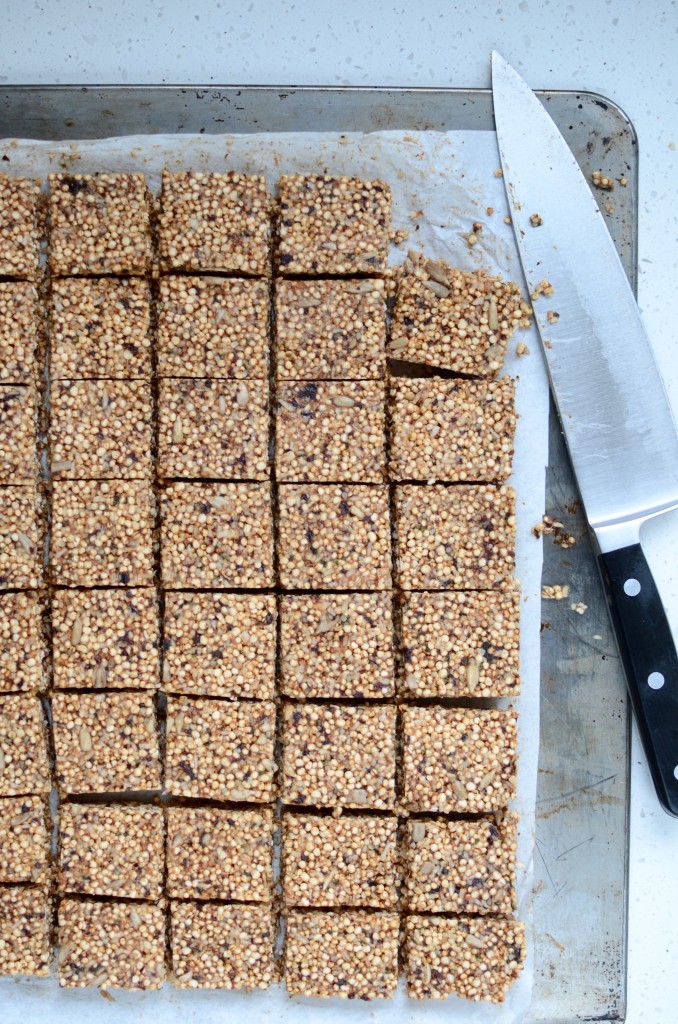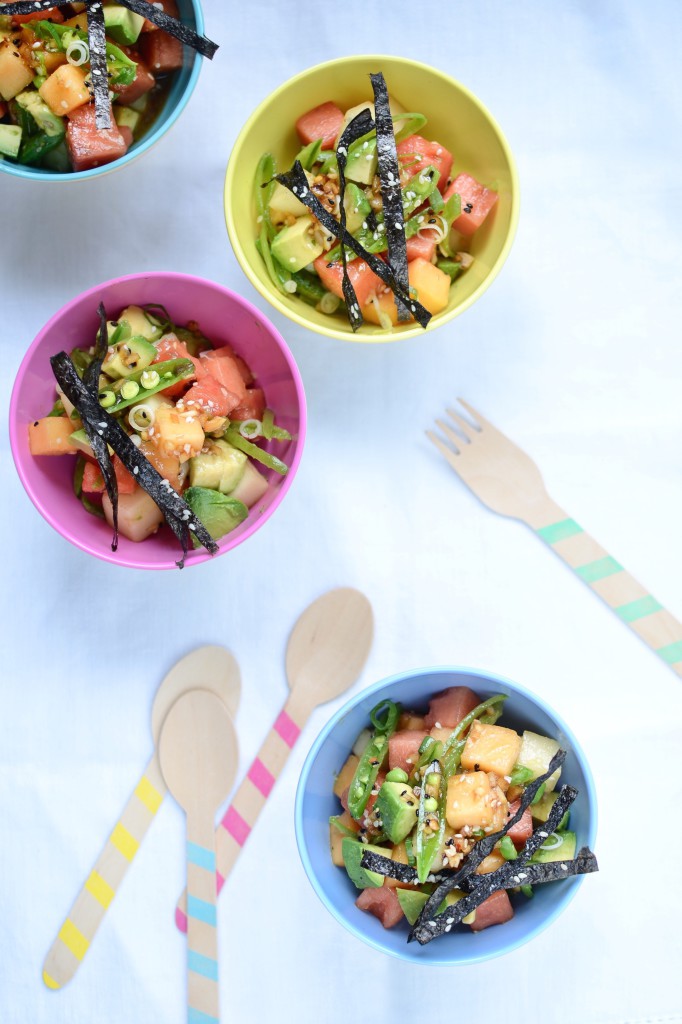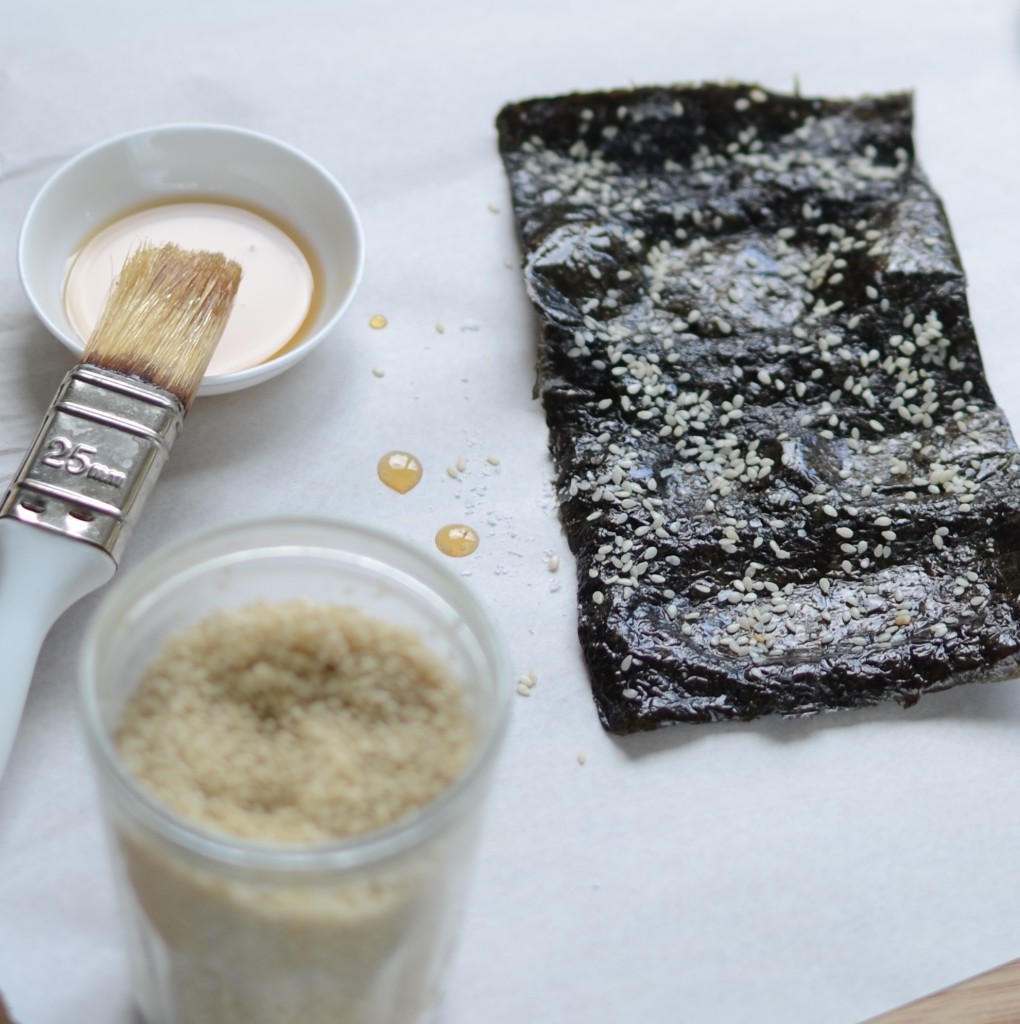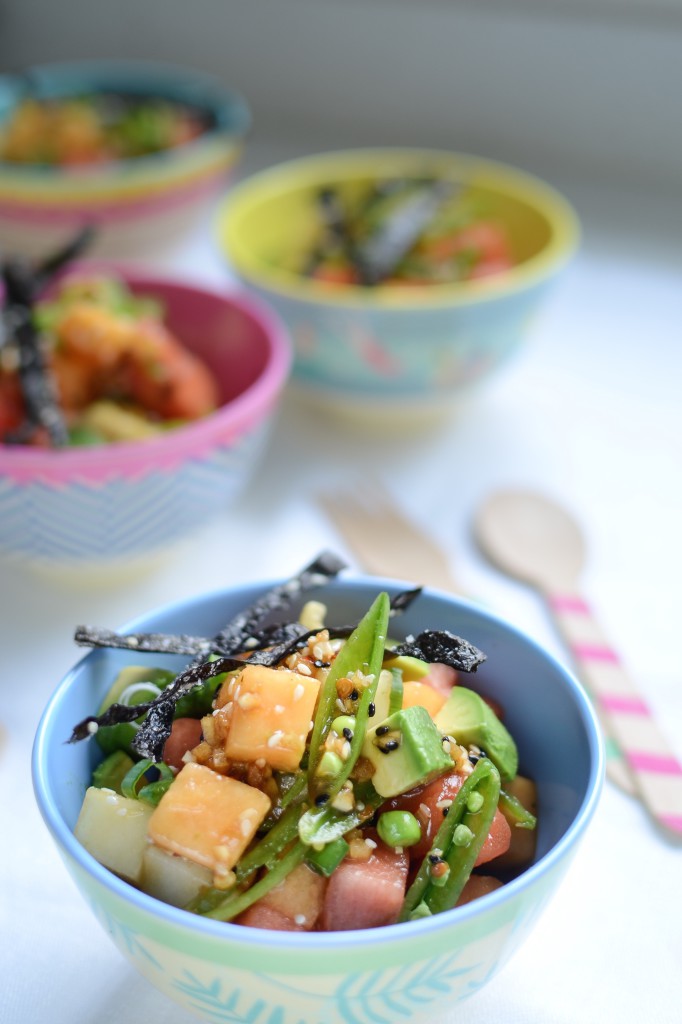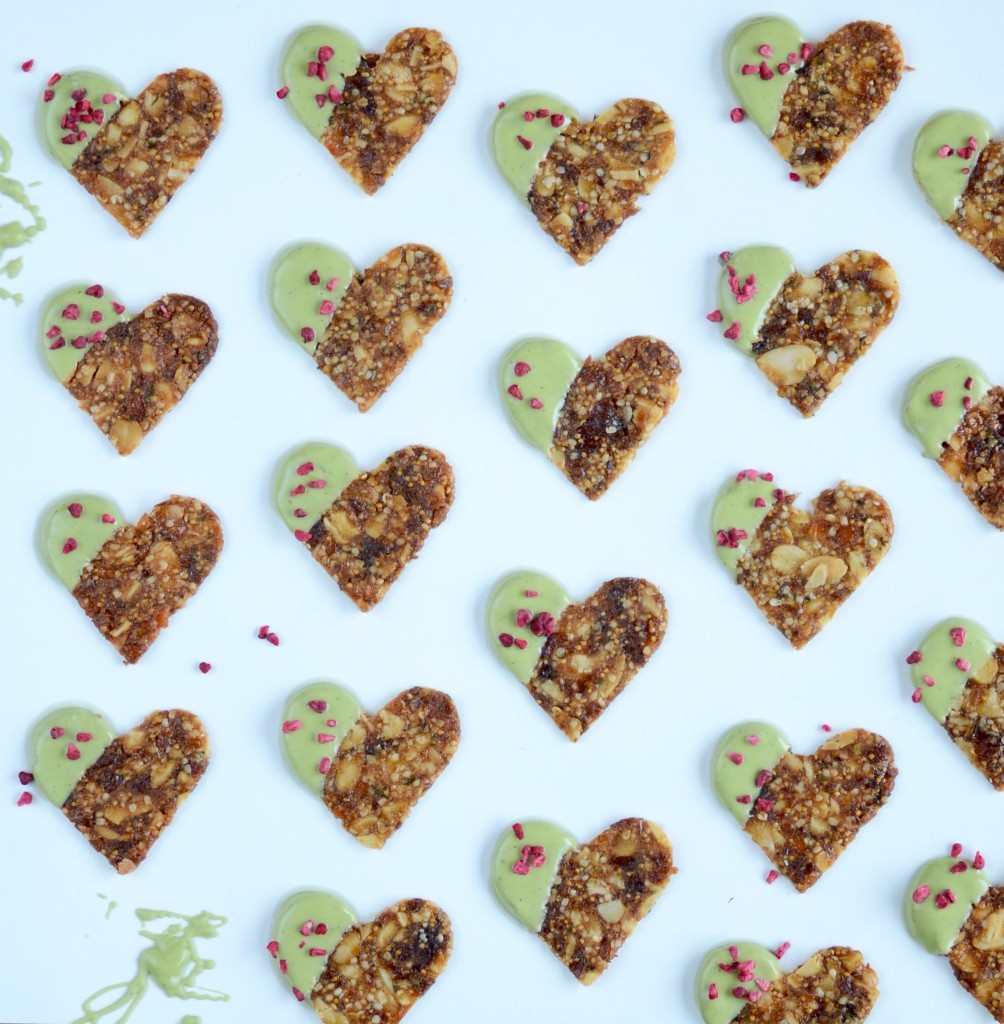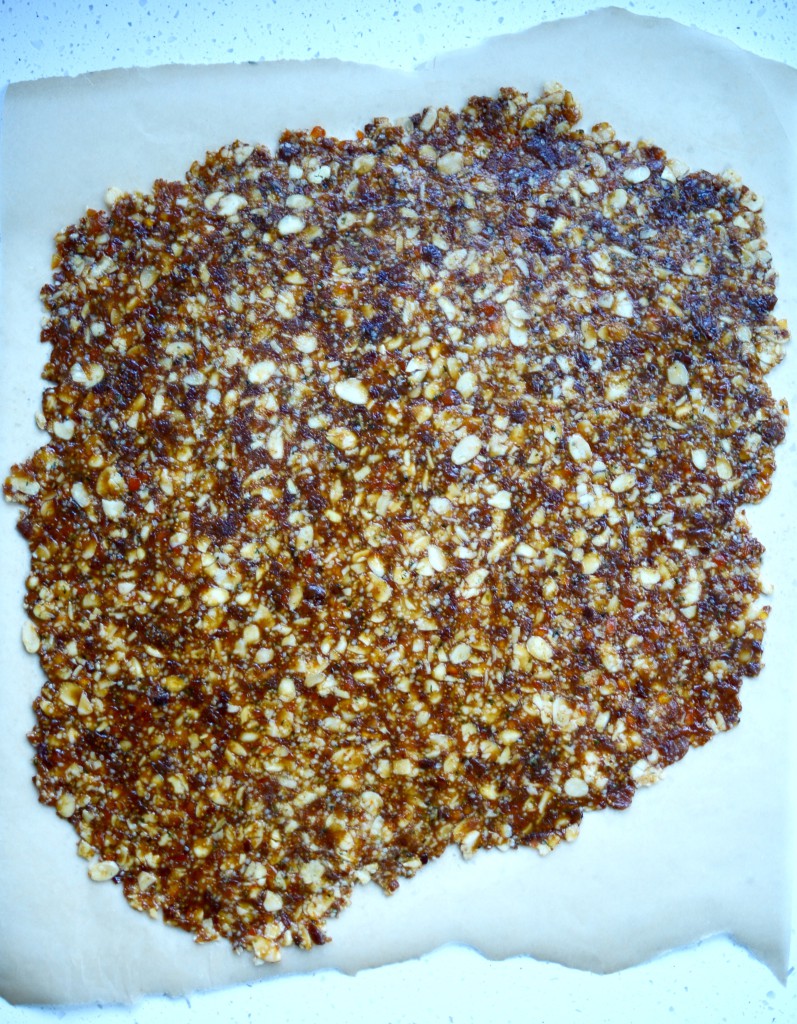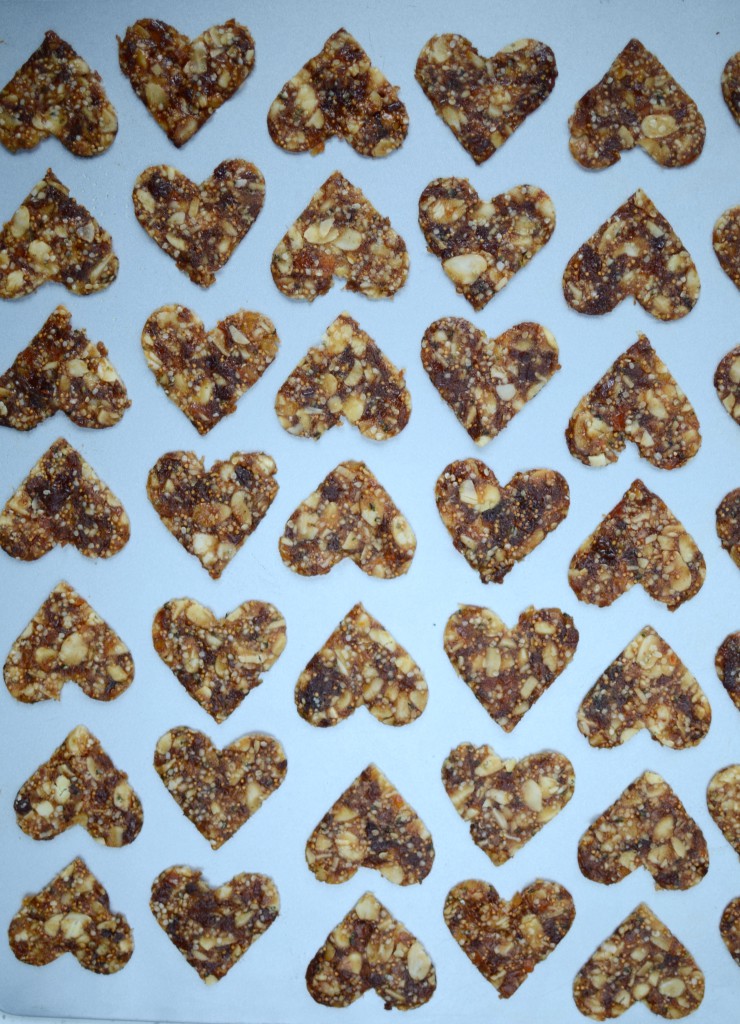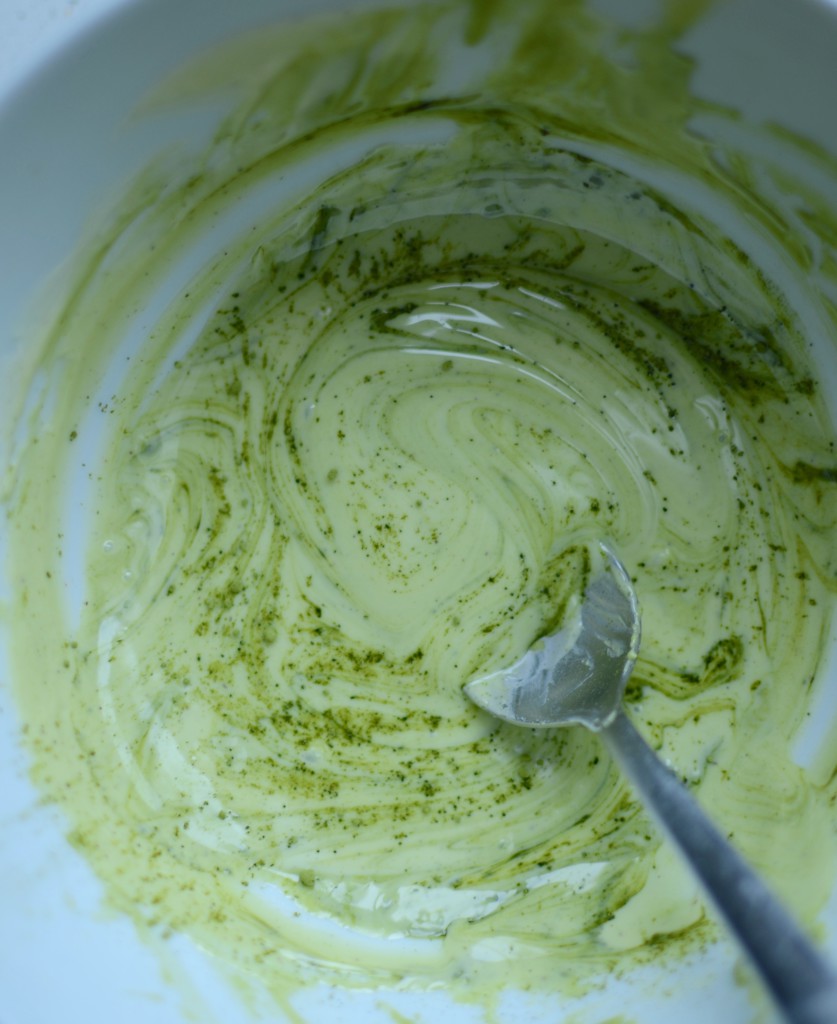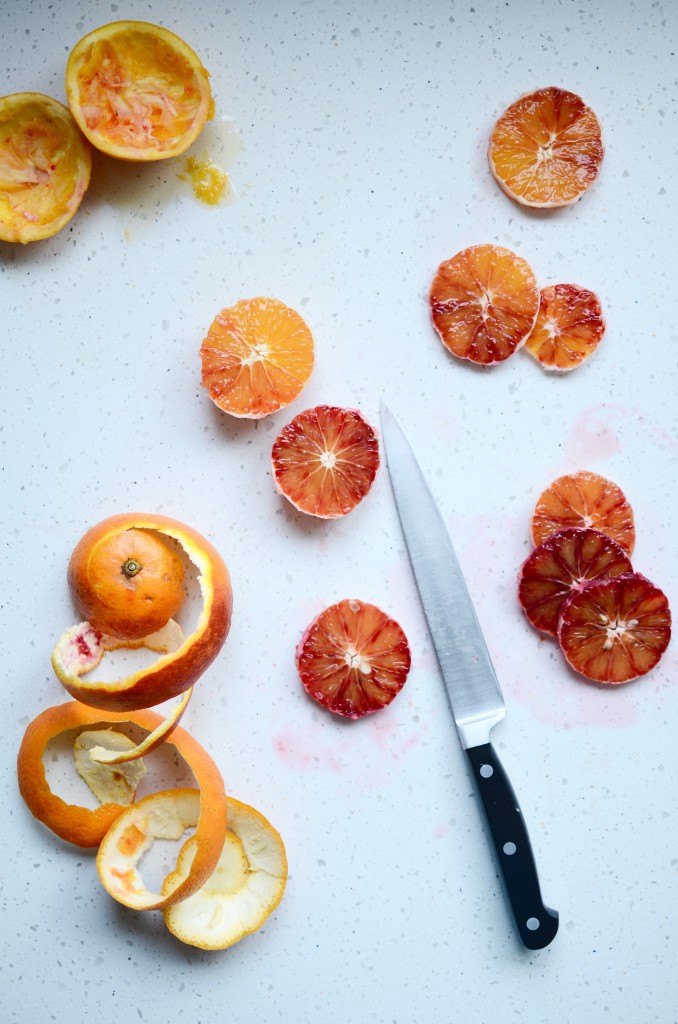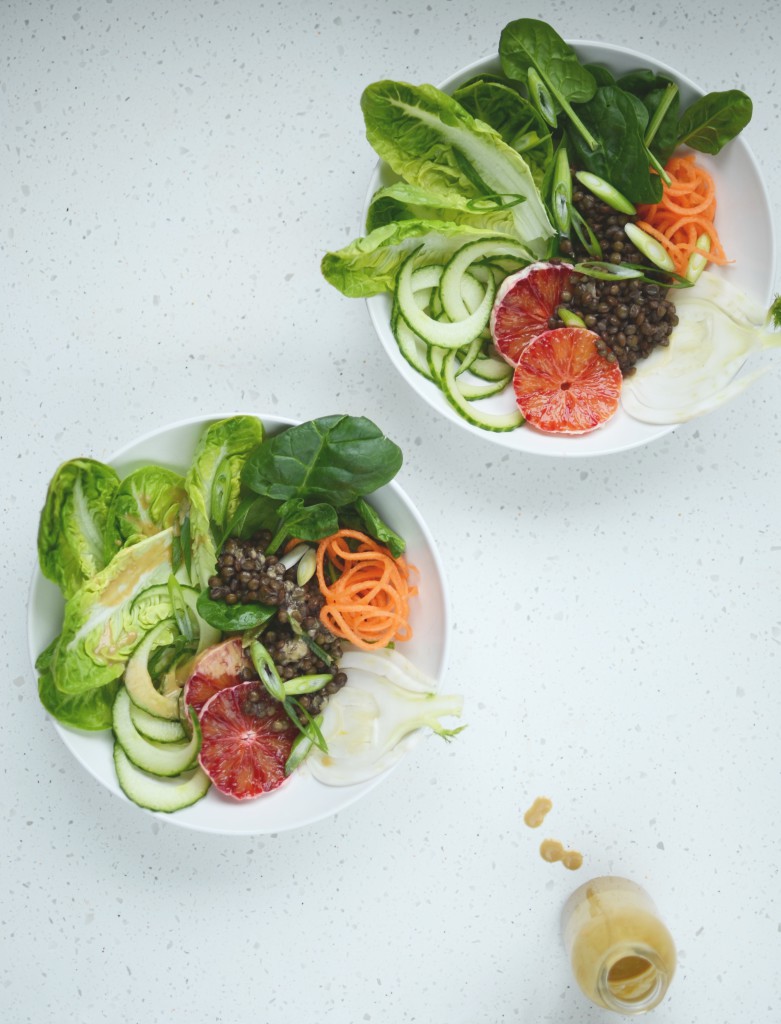Chocolate bark with macadamia nuts, dried banana and sea salt
Another delicious topping for chocolate bark is a combination of toasted macadamia nuts, dried bananas and flaked sea salt. Drizzle everything with melted milk chocolate and ta-dah!
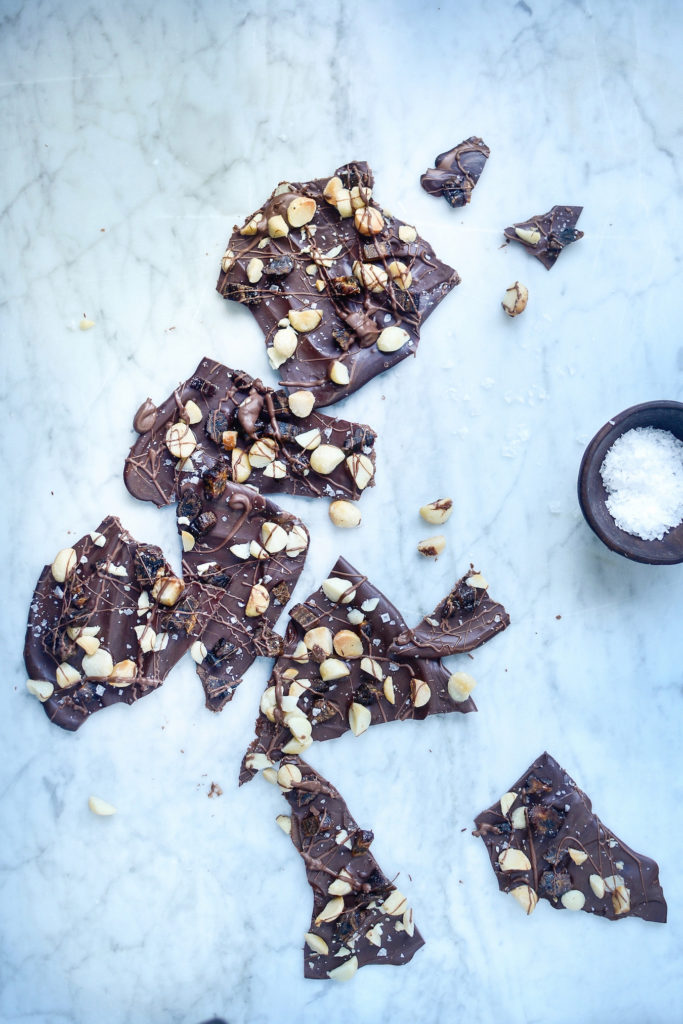
Chocolate bark with macadamia nuts, dried banana and sea salt
Makes enough for 2 – 4 little bags
Ingredients
150g dark chocolate (minimum 60% cocoa solids)
large pinch of sea salt flakes
30g (1/4 cup) macadamia nuts, toasted for 5 minutes at 180˚C pre-heated
30g dried bananas, finely chopped
5g popped quinoa, optional
20g milk chocolate
Method
- Melt 2/3 of the dark chocolate in a double boiler until just melted, stirring continuously. As soon as it has melted, stir in the rest of the chocolate until all has melted. You could also melt the chocolate in a microwave in 15 second bursts, stirring after each, until just melted. Do not let the chocolate get warm.
- Pour the melted chocolate onto a large piece of greaseproof paper and quickly spread out to about 1/4” thickness with a spatula.
- Quickly scatter over all the toppings evenly.
- While the bark is cooling, melt the milk chocolate in the same way as the dark chocolate. Either drizzle this over the bark with a spoon or use a small sandwich bag (or piping bag) to pipe the melted chocolate onto the bark. Set aside to cool completely.
- Peel away the paper and snap into pieces.
Rhubarb and apple crumble
It’s rhubarb season! The word “forced” used to lead me to believe that this kind of rhubarb is somehow inferior, but I have since come to love this delicious late winter treat. Lifting sections of the rhubarb roots and bringing them under the cover of a greenhouse or other warmer place, shutting out all light, creates stems that grow pale. This means the light-starved plants desperately reach out in search of light and thereby produce smooth, bright crimson stems (rather than green ones created post photosynthesis). The Rhubarb Triangle in West Yorkshire produces some of the world’s finest. Forced rhubarb is less bitter than the traditional, non-forced stalks and needs less sugar to balance the tartness. Pretty in pink and less astringent – perfect!
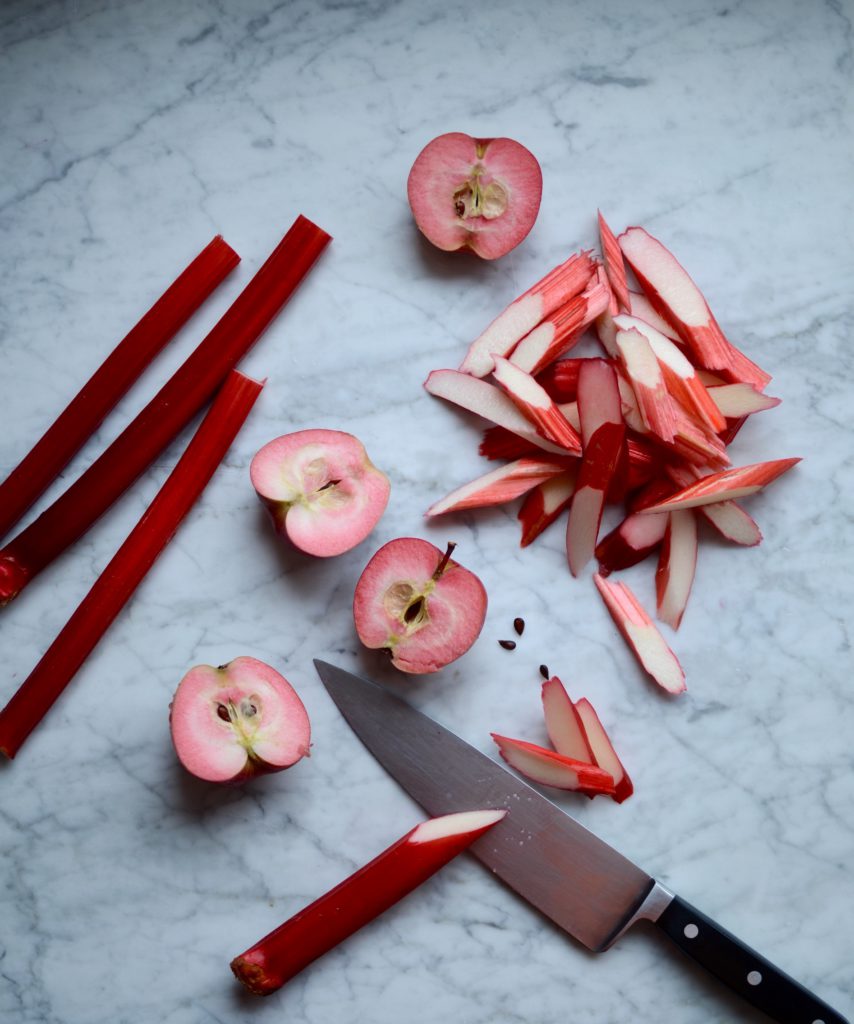
Rhubarb and apple crumble
Serves 4 – 6
Ingredients for the fruit filling
500g rhubarb, washed and sliced into 1/2 cm pieces
2 apples, cored and thinly sliced
zest of 1 orange
juice of 2 oranges
40g dark muscovado sugar
1 cinnamon stick, broken into 2 or 3 pieces
Ingredients for the topping
85g cold unsalted butter (preferably organic) or ice cold coconut oil, cut into little cubes
50g mixed nuts, roughly chopped (I used a combination of almonds, pecans and walnuts)
30g demerara sugar
70g muesli base (mine is a mix of oat, rye and quinoa flakes, but you can use any combination)
70g wholemeal rye flour (or use wholemeal spelt or you favourite gluten-free mix)
1 teaspoon ground cinnamon
pinch of salt
Method
- Preheat the oven to 180°C (370°F).
- Mix all the ingredients for the filling in a large bowl, then transfer to a medium ovenproof dish and cover with a lid or foil. Bake for 45 minutes (or until the fruit is tender when tested with a sharp knife), stirring carefully half-way through the cooking time.
- In the meantime, place all the topping ingredients apart from the butter in a bowl and mix well. Now add the butter (or coconut oil) and quickly rub into the dry ingredients until it comes together and you are able to form large clumps. Spread the clumps out on a baking sheet and place in the oven with the fruit. The crumble topping should be ready after about 30 minutes, but use a spatula to turn the pieces over gently half way.
- To serve, divide the fruit amongst 4 – 6 bowls, spoon over the delicious juices, scatter the crumble over the fruit and serve with vanilla-sweetened whipped cream or vanilla ice cream of your choice.
Note: If you use coconut oil and gluten-free flour, your crumble will be a much finer texture, but still crunchy and delicious.
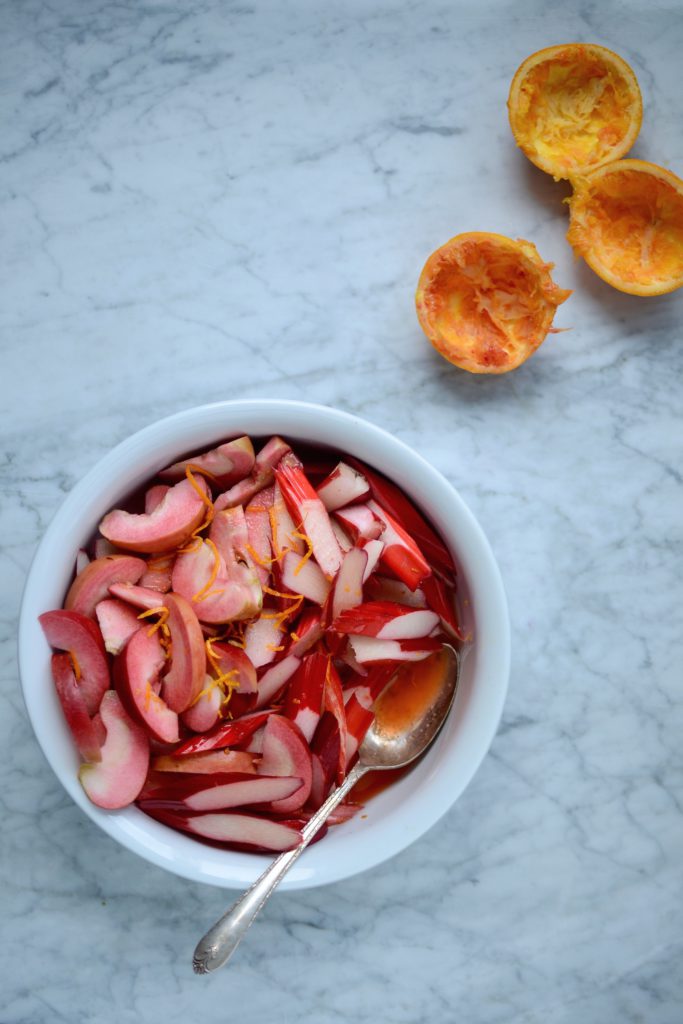
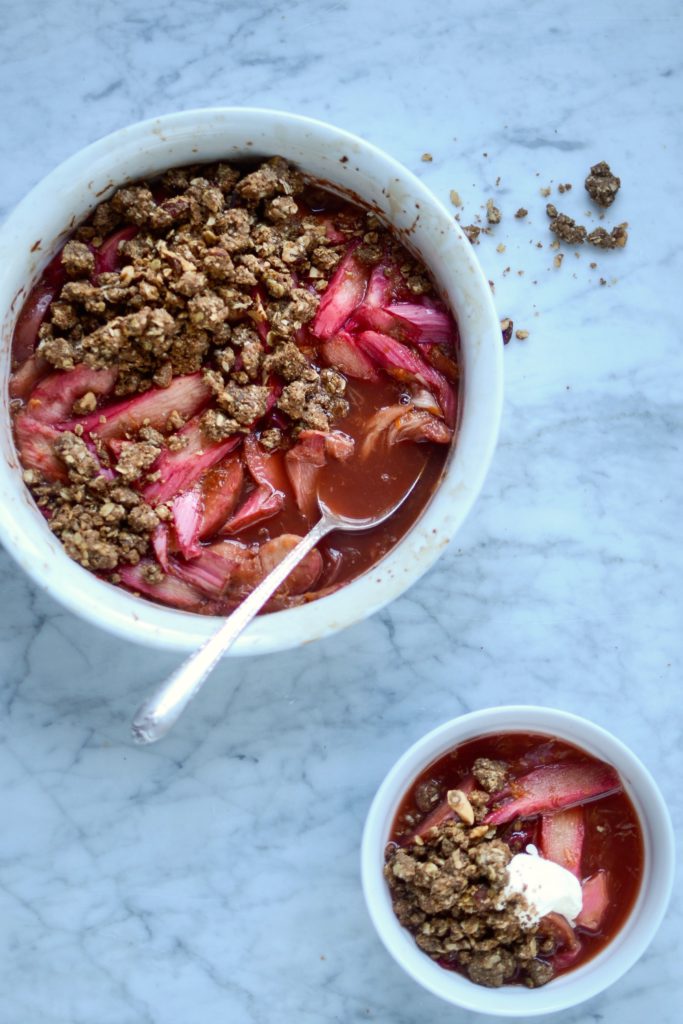
Bergamot and cucumber salad
I only recently discovered my love for Earl Grey tea. Not the regular kind, mind you. It was the combination of Redbush tea from my homeland with the intoxicating aroma from the Bergamot oil that swayed me. The Bergamot orange (sometimes mistakenly referred to as a lemon) was created more than 300 years ago in Southern Italy when a sour orange was crossed with a citron/lemon/lime/Palestine sweet lime. No one is quite sure. The oil is extracted from the rind and used in Earl Grey teas, as well as fragrances, aromatherapy and to flavour dishes. Here I’ve put them to good use in a refreshing salad dressing with cucumber and blueberries. But the options really are endless…
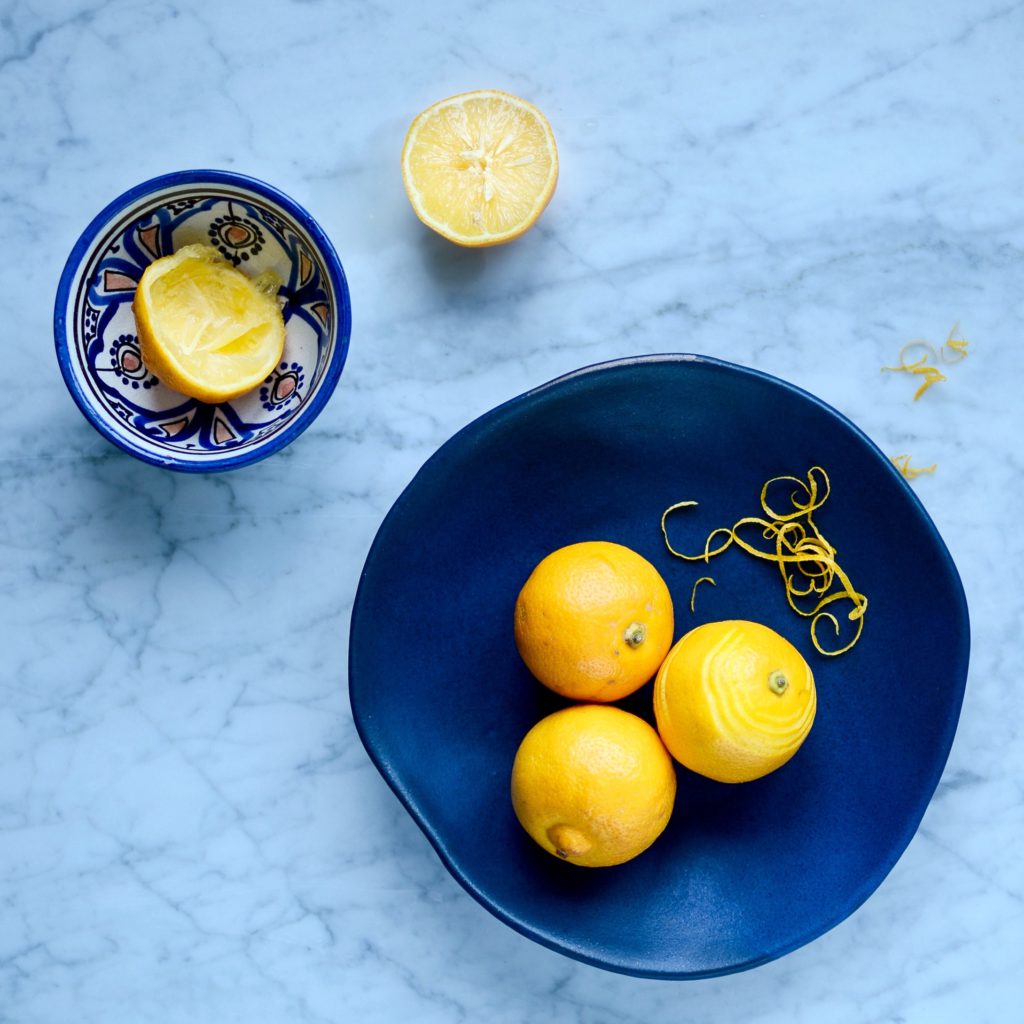
Bergamot lemon cucumber salad
If you cannot find Bergamot oranges (in season from December to February) try a combination of lemon, grapefruit and orange or tangerine, although the distinctive floral, slightly bitter flavour is difficult to replicate.
Serves 4 – 6
Ingredients for the salad
2 English cucumbers, peeled if not organic
1 punnet blueberries (about 125g), washed and halved if you prefer
a large handful of pistachio nuts, roughly chopped
Ingredients for the dressing
zest of 2 Bergamot oranges
juice of 1 Bergamot orange
80ml thick Greek yoghurt (or coconut yoghurt)
45ml (3 tablespoons) extra virgin olive oil
1 garlic clove, crushed
large pinch of unrefined rock or sea salt
1 – 2 teaspoons raw honey (or maple syrup), or to taste
small bunch of dill, leaves only, finely chopped
Method
- Thinly slice the cucumber on the diagonal and gently toss with a pinch of unrefined salt. Place the cucumber slices in a colander over a bowl or in the sink and allow to drain for at least half an hour.
- Put all the ingredients for the dressing in a jar, screw on the lid and give it a good shake until the honey is dissolved.
- Add the rest of the salad ingredients, toss with the dressing and serve immediately.
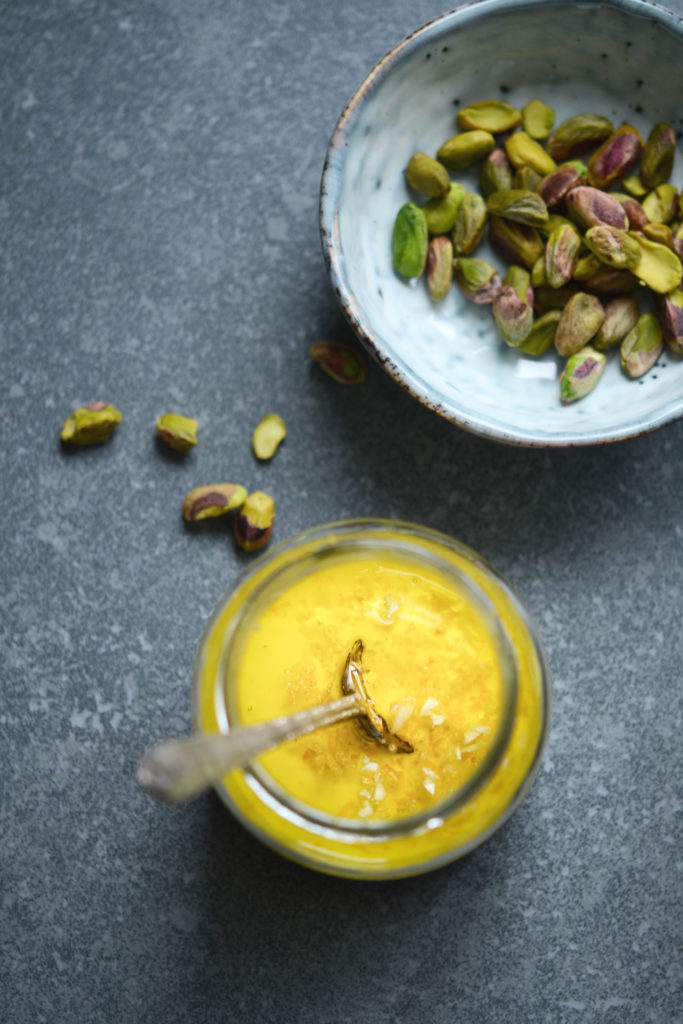
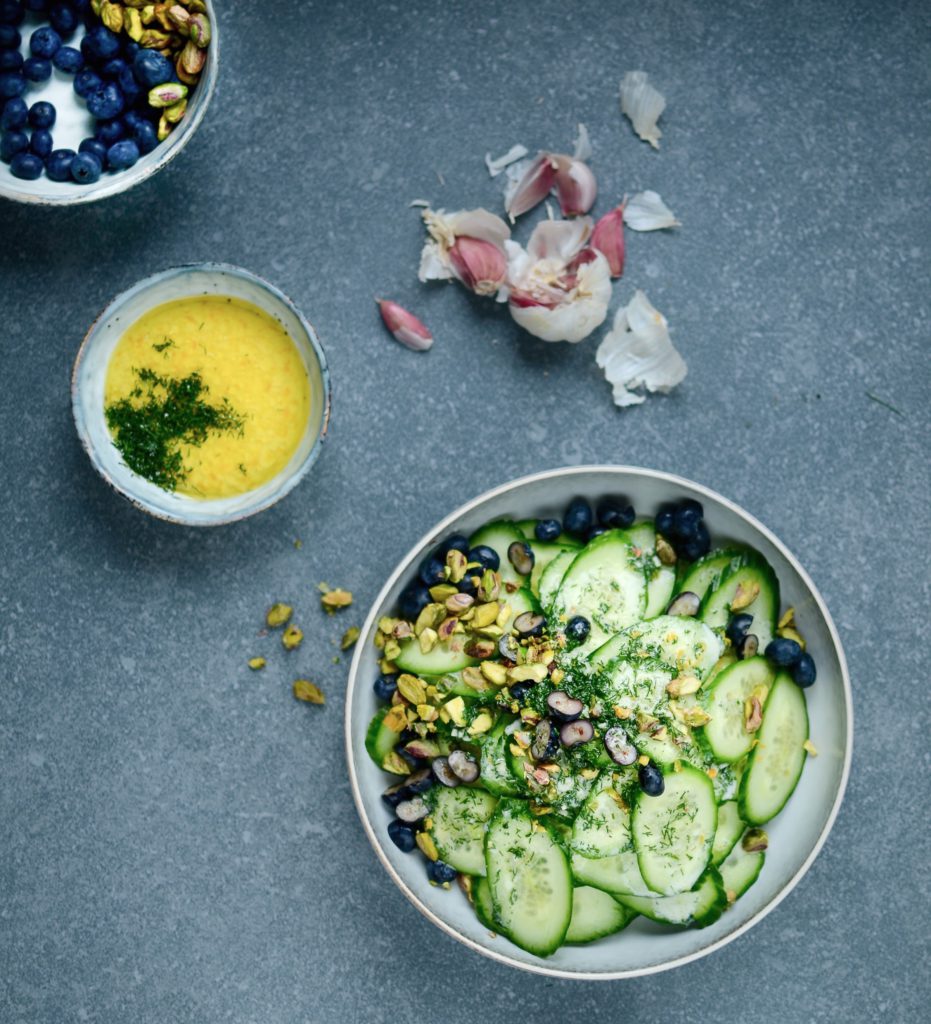
Turmeric poached pears with macadamia nut cream
I love brunches so much, that I centre most of my social engagements around them (click here and here for some easy recipe ideas). Not too early, with an array of delectable foods to choose from, most often vegetable-heavy, and no rush to leave, it is by far my favourite kind of meal. I especially like being creative and pushing boundaries when it comes to menu ideas, so I really enjoyed collaborating with M&S on their Super Brunch campaign using their new Chef range cookware. The products are well-designed, solid and beautiful to look at, and being part of a brunch initiative has me smiling from ear to ear. These pears would make a great addition to any brunch spread, but would also be a spectacular dessert, perhaps with a few candied macadamia nuts scattered over the top.
A lot has been written about curcumin, an active compound in turmeric believed to have many health benefits since they are powerful antioxidant, anti-inflammatory, antiseptic, anti-fungal and anti-bacterial agents. But interestingly enough, turmeric is not that easy for our bodies to assimilate, as most of it is metabolised by the liver before being absorbed. Studies have now shown that eaten with even just a tiny amount of black pepper, absorption of the curcumin is a lot higher, because the chemical compound “piperine” in the pepper inhibits this metabolisation. Bioavailability of curcumin is also higher when eaten with a fat, as it can then be directly absorbed into the bloodstream through the lymphatic system thereby in part bypassing the liver.
Turmeric poached pears with macadamia nut cream
Serves 6
Ingredients for the pears
6 – 7 ripe but firm pears
5cm (2”) piece of fresh turmeric, scrubbed cleaned (or peeled if not organic) and thinly sliced
thumb-sized piece of ginger, scrubbed cleaned (or peeled if not organic) and thinly sliced
a few gratings of coarse freshly ground black pepper
500 – 600ml dry white wine
40ml (2 1/2 tablespoons) maple syrup
Ingredients for the macadamia nut cream
140g (1 cup) macadamia nuts, soaked in filtered water for 2 – 4 hours
80ml (1/3 cup) reduced poaching liquid
unrefined salt
Method
- Peel the pears, taking care to leave the stalk in tact. Place the pears, turmeric, ginger, black pepper and white wine into a medium, deep saucepan like this one I was recently sent by M&S, and set over medium heat.
- Cut a circle out of greaseproof parchment paper just large enough to fit into the saucepan and lay over the pears in the wine (this is called a cartouche and prevents the liquid from evaporating too quickly whilst the fruit is poaching).
- As soon as you see tiny bubbles form under your cartouche, turn the heat down very low and allow the pears to poach for 15 minutes. Test with a sharp paring knife – the pears should be tender, but not too soft.
- Remove the pears carefully with a slotted spoon and set aside.
- Turn the heat up high and boil the wine with the flavourings until it has reduced by about two thirds to three quarters. You will need about 160ml (2/3 cup) of reduced liquid.
- Now add the maple syrup, whisk and set aside to cool slightly.
- To make the macadamia nut cream, rinse the soaked nuts and place in a blender with roughly half (about 80ml) of the reduced poaching liquid and a small pinch of salt. Blend until the cream is very smooth – if you do not own a high speed blender, you might have to keep going a bit longer.
- Serve the pears with the cream and remaining poaching liquid.
*This blog post was written in collaboration with M&S. All content and photos my own.
Apricot, red currant & butternut cake
I absolutely love cooked apricots, whether in a cake, jam, compote, tart or savoury dish. I find that they offer the perfect balance of flavour, and the vibrant colour is always a treat. This cake has a firm texture and is not very crumbly, so makes for an ideal dessert to take along on a picnic. Use frozen red currants if you can’t find fresh.
Apricot, red currant and butternut squash cake
Makes one 20cm cake
Ingredients
3 medium eggs
150ml (1/2 cup plus 2 tablespoons) macadamia nut or extra virgin olive oil
140g (1 cup) palm sugar or dark muscovado sugar
1 vanilla pod, cut into smaller pieces (or just the seeds if you are not using a high-speed blender)
130g (1 cup) wholemeal spelt or buckwheat flour
1 teaspoon baking soda
1 teaspoon baking powder
pinch of sea salt
165g (1 1/2 cups) grated peeled butternut squash
150g red currants, stripped from the stalks
8 small apricots, halved and stone removed
Toasted macadamias, optional
Method
- Pre-heat the oven to 180°C/360°F, and grease a 20cm spring form.
- In a blender, whisk together the eggs, oil, sugar and vanilla pod pieces (or vanilla seeds, if not using a strong blender).
- Mix together the flour, baking soda, baking powder and salt. Make a well in the centre and add the egg mix. Stir until just combined.
- Stir in the butternut and half the red currants, then scrape into prepared tin.
- Place the apricot halves, cut sides down, onto the cake batter and scatter the rest of the currants on top. Use the back of a large spoon to gently press the fruit into the batter.
- Bake for about 60 minutes or until a toothpick inserted in the centre of the cake comes out clean or with a few dry crumbs. It may need a little longer, depending on your oven.
- Let the cake cool in the pan for 10 minutes, then turn out onto a wire rack to cool.
- Serve with whipped cream and toasted macadamia nuts.
Strawberry and tomatillo salsa
Tomatillos look like little green tomatoes but are, in fact, related to the cape gooseberry (or physalis). They are a staple in Mexican cooking, and with their tart, refreshing taste, make a great addition to all kinds of dishes, especially salsa verde. Once you’ve removed the husk, rinse them well as they are sticky, then chop or blend and add to guacamole, or cook it down with red onion and chilli for the most delectable sauce. I received mine with my weekly Riverford Organic box, but you could also try online grocers specialising in Mexican ingredients.
Strawberry and tomatillo salsa
Delicious with a Mexican-inspired barbecue or grilled fish, this salsa is a lovely alternative to your regular tomato version. Make sure your strawberries are super sweet – the salsa needs it. Tomatillos are a good source of niacin, potassium, and manganese, and are very rich in vitamin C and vitamin K. They also contain iron, magnesium, phosphorus, and copper.
Serves 4 – 6
Ingredients
juice of 1 lime
large pinch of sea salt
1 teaspoon raw honey
1/2 red onion, finely diced
200g tomatillos, finely chopped
400g strawberries, hulled and quartered
small bunch fresh coriander, finely chopped
1 – 2 red or green chillies, chopped (deseeded if preferred), optional
Method
- Whisk together the lime juice, salt and raw honey. Then add the onion and set aside.
- Prepare the rest of your ingredients, then toss with the dressed onions and serve.
Puffed quinoa squares
A relative unknown a few years ago, South American-born Quinoa has since crept into our hearts and is unlikely to disappear anytime soon. This little pseudo-grain is very nutritious, rich in protein and gluten-free to boot, making it an ideal addition to any meal. It is most often cooked and prepared in the same way as rice, but I love grinding and making a delicious breakfast porridge with it. You can also make puffed quinoa as if you were making popcorn. Heat a large heavy bottomed pot (cast iron ones work best) and add about half a cup of quinoa. Keep shaking the pot until most of the seeds have popped. If your pot is deep enough, you won’t need a lid to keep the little nippers at bay. Tip them out onto a baking sheet to cool and use in muesli, as a topping on yoghurt or in recipes such as these squares below.
Puffed quinoa squares
The squares make an excellent after-school snack, as they are a mini version of a complete meal.
Makes about 40
Ingredients
200g (1 1/2 loosely packed cups) soft, dried prunes
125ml coconut water, at room temperature and preferably raw (i.e. unpasteurised)
150ml (125g or 1/2 cup plus 2 tablespoons) liquid coconut oil
125ml (1/2 cup) raw honey
Pinch of sea salt
5 cups puffed quinoa (home-made or store-bought)
90g (1 cup) toasted desiccated coconut
70g (1/2 cup) shelled hemp seeds
70g (1/2 cup) shelled sunflower seeds
Method
- Soak the prunes in the coconut water whilst you get your other ingredients together.
- In a powerful blender, blend the prunes, coconut water and enough of the coconut oil to give you a smooth paste. Scrape into a bowl.
- Add the rest of the oil, honey, salt, quinoa, desiccated coconut and seeds, and stir until well combined. Your mixture needs to be sticky and hold together when pressed.
- Line a 34cm x 26cm (9” x 13”) tin or oven dish with greaseproof paper, then press the mixture into the tin and refrigerate until set (at least a couple of hours).
- Turn out onto a chopping board and cut into squares. They will keep a week or so in the fridge, and freeze really well.
Melon and avocado poke
This is refreshing and utterly summery. Unlike the British weather. (Here’s hoping the guys at the met office are right about that heat wave…) Poke (pronounced poke-keh) is a Hawaiian staple and can be found in many different guises, with chunks of tuna marinated in soy being the most popular and ubiquitous. This is a meat- and fish-free version and something I love eating whilst sat on my garden chair with the sun kissing my toes. It serves 4 as a starter, but I often eat the entire bowlful for lunch. Whatever you do, only attempt this if you can get your hands on seriously good melons.
Melon & avocado poké with nori crisps
Serves 4 as a starter
Ingredients for the nori crisps
2 sheets nori
white sesame seeds
sesame oil
sea salt
Ingredients for the dressing
15ml (1 tablespoon) extra virgin olive oil
5ml (1 teaspoon) rice wine vinegar
5ml (1 teaspoon) toasted sesame oil
15ml (1 tablespoon) tamari
30ml (2 tablespoons) lemon juice
1/2 – 1 teaspoon raw honey
1 teaspoon each of white and black sesame seeds, plus more for garnish
pinch of dried chilli flakes (or to taste)
1 shallot, very finely chopped
1 large clove garlic, finely chopped
Ingredients for the poké
500g (3 1/2 cups) diced watermelon (or a mixture of melons)
2 ripe avocado, cut into small dice
large handful sugar snap peas, thinly sliced lengthways
1 spring onion, finely sliced
sea salt
Method
- For the nori crisps: Preheat the oven to 140°C (275°F). Line a large baking sheet with parchment paper and set aside. Place two sheets of nori, shiny side up, on a chopping board. Using a pastry brush, lightly brush one sheet with water, then press the other one firmly firmly on top to stick the two together.
- Now brush the uppermost sheet with sesame oil, sprinkle on some sea salt and sesame seeds, and using scissors or a sharp knife, cut the nori into thin strips.
- Arrange the strips in a single layer on the baking sheet and bake for 15 to 20 minutes or until they have turned crispy and dark green. Remove from the oven and allow to cool.
- For the dressing: Combine all the ingredients in a jar and give it a good shake. Taste and adjust seasoning.
- To serve: Gently toss together the melon and other poké ingredients with the dressing and serve immediately topped with nori crisps.
Chewy almond and fig thins
It doesn’t really matter when you make these, but you should! They are rather easy to throw together and definitely hit the spot when you need a little something to cheer up your darling (or yourself!). If you can’t find matcha powder, use a few drops of beetroot juice instead, to colour the chocolate pink.
Chewy almond and fig thins
Ingredients
50g unsalted organic butter (or coconut oil)
50g coconut palm sugar (or you could use demarara sugar)
Pinch of sea salt
65g orange marmalade, very finely chopped
100g soft dried figs, finely chopped
80g flaked blanched almonds
30g shelled hemp seeds (also called hemp hearts)
25g brown rice flour
For the chocolate drizzle
100g organic white chocolate, broken into pieces
matcha powder (roughly 1 teaspoon)
freeze-dried raspberries or additional hemp hearts
Method
- Pre-heat the oven to 180°C/350°F and line two baking trays with parchment paper.
- Melt the butter and palm sugar in a small pan over a medium heat until the sugar is dissolved. Add the salt, give it a stir and set aside.
- Put the rest of the ingredients in a bowl and using a tablespoon, press everything against the sides to mix thoroughly and evenly distribute the flour. Add the butter and sugar mix and repeat the process until you have a lovely dark golden ball of deliciousness.
- Place this ball between two large pieces of parchment paper and roll it out until it is quite thin (how thin will depend on your preference, but I have found that 4mm is just about perfect). Slide onto a baking sheet and bake for about 10 minutes before removing from the oven.
- Now cut out shapes with a cookie cutter (press any offcuts together and roll them out again) or for a lot less effort, use a large knife to cut the cookie dough into rectangles. Place on the lined baking trays and return to the oven for another 8 – 10 minutes, rotating the trays half-way. Remove from the oven and transfer to a cooling rack to cool completely.
- When cool, melt the white chocolate in a double boiler or in a heatproof bowl set over a pan of simmering water (don’t let the bowl touch the water!) and stir every now and then. As soon as the chocolate has melted, add enough matcha powder for a lovely green hue.
- Dip each cookie in the melted chocolate half-way and sprinkle with freeze-dried raspberries or additional hemp hearts. return to the cooling racks and store in an air-tight container when set. You could also spread chocolate on the underside of each cookie and let it cool upside down. You will need more than 100g of chocolate, but it is more traditional. And reeeeeally good.
Note: If you are not a fan of white chocolate, feel free to use dark chocolate instead.
A winter salad with blood orange and lentils
I’m not sure that I agree with a strict interpretation of the whole “New Year Detox” thing. At least not if you live in the Northern hemisphere. Sure, cut down on portion sizes and avoid sweet things if you overdid it during the festive season. But why deny yourself warming, filling and indulgent food when it is bound to be cold, dark and wet most of the time? And on the days you do crave something a little fresher, a little bit brighter, a salad such as this one will hit the spot while keeping the winter chills at bay.
Blood oranges are such a treat in the colder months and add a sense of drama to any dish. Before juicing the halves for the dressing, I cut off one slice and add this, with the skin still on, to the blender. This, and the tahini, add a delicious bitterness to the salad, which I find particularly appealing, but feel free to omit it. If you struggle to find the shichimi togarashi spice blend for the dressing, you could make your own by combining 2 tablespoons of chilli flakes, 1 teaspoon coarsely ground sichuan (or black) peppercorns, a tablespoon each of white and black sesame seeds, and dried tangerine or orange peel, 2 teaspoons of ground ginger, and lastly 2 tablespoons of seaweed (nori, wakame flakes or arame). Also remember, when consuming raw spinach, to include foods in the meal that are high in vitamin C (such as blood oranges), as it helps with assimilation of the iron and blocks the oxalate from binding to calcium, encouraging further absorption.
Lentil and blood orange salad
Serves 2 – 4
Ingredients for the dressing
1 blood orange, 1 slice and the rest juiced
80ml (1/3 cup) extra virgin olive oil
15ml (1 tablespoon) tahini
30ml (2 tablespoons) rice vinegar
15ml (1 tablespoon) naturally fermented shoyu or soy sauce
1 tablespoon maple syrup
squeeze of lemon
pinch of sea salt
shichimi togarashi (Japanese 7-spice blend) to taste
Ingredients for the salad
100g (about 1 cup) cooked puy lentils
2 large handfuls of greens, including baby spinach
1/2 large cucumber, sliced
2 blood oranges, peeled and sliced
1 large carrot, grated or thinly sliced
1/2 medium fennel, grated or thinly sliced
2 spring onions, thinly sliced
Method
- Blend together all the dressing ingredients. If you don’t own a high-speed blender, do not add a slice of orange with the peel on, as it will not be ground up smoothly enough. Instead, add some grated zest. Adjust seasoning, ensuring a lovely balance between salty, bitter, sweet and sour.
- Just before serving, toss together the warm lentils, the rest of the salad ingredients and enough dressing to coat.

